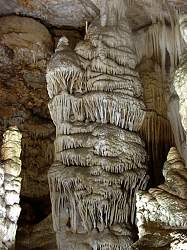Cuevas de Campanet
Coves de Campanet - Caves of Campanet
Useful Information

| Location: |
Near Campanet, Mallorca.
From C713 Palma - Alciúdä, 34 km from Palma, 16 km from Alciúdä turn north on PMV-2132 2 km to Campanet.
2 km to the North. Forty kilometers north east of Palma de Mallorca is a small village which gives its name to the cave - Campanet. The quickest route is via the C-713 Palma to Alcúdia motorway taking the exit atkm 39 signposted Cami de na Pontons. |
| Open: |
Apr-Sep daily 10-19. Oct-Mar daily 10-18. [2012] |
| Fee: |
Adults EUR 9, Children (4-14) EUR 2.50, Children (0-3) free, Seniors EUR 2.50. [2012] |
| Classification: |
 Karst Cave Karst Cave
|
| Light: |
 Incandescent Incandescent
|
| Dimension: | T=21 °C. |
| Guided tours: | L=1,300 m, D=40 min, in several languages. |
| Photography: | |
| Accessibility: | |
| Bibliography: |
Anne Oldham (1972):
Majorca,
The British Caver, Vol 59, pp 5-10. |
| Address: |
Coves de Campanet, Campanet, Mallorca, Tel: +34-971-516130, Fax: +34-971-516130
E-mail: |
| As far as we know this information was accurate when it was published (see years in brackets), but may have changed since then. Please check rates and details directly with the companies in question if you need more recent info. |
|
History
| JUN-1945 | discovered by workers digging a well. |
| 10-NOV-1948 | opened to the public. |
Description

The cave was discovered in 1945 whilst workers were digging a well and opened to the public in 1948. Although not as crowded as some of the other caves on the island, the speleothems alone are well worth a visit.
The cave is consists of several chambers which extend to just over 300 m. They are formed in the dolomites of the Upper Triassic of the Rhaetian Age.
A short artificial tunnel leads to the Sala de la Palmera or Palm Tree Chamber. To the north west a low passage leads to the Sala del Llac or Lake Chamber which is graced by a crystal clear lake which reflects the surrounding spelothems. A circular route around this chamber leads back to the Sala de la Palma. Travelling north eastwards one enters the final room, the Sala Romántica or Romantic Chamber. This is the largest chamber in the cave being 50 m across and 10 m high. The chamber is noted for the massive stalagmite columns.
Text by Tony Oldham (2002). With kind permission.
It began, when Guillem Torres i Cladera, the owner of this Possessió, decided to dig a well. He needed water for his fields, and so he was looking for a good place where ground water could be found. His Bartomeu Palou i Bennàsser, who was the waller of the farm, know about the small hole in the ground, only 15 cm in diameter, which emanated cool and humid air. He also thought there was the sound of water, and so they tried to open the hole and to reach the water. As a result they discovered the cave. Bartolomeu built a stone staircase into the cave and Antoni Salvà i Torres aquired the permission to run a show cave. The surroundings of the cave were built by the architect Josep Ferragut. The cave was developed and opened to the public on the 10-NOV-1948.

|
| Cuevas de Campanet Gallery |
 Search DuckDuckGo for "Cuevas de Campanet"
Search DuckDuckGo for "Cuevas de Campanet" Google Earth Placemark
Google Earth Placemark *** Coves de campanet *** Mallorca (visited: 09-JAN-2012), official website
*** Coves de campanet *** Mallorca (visited: 09-JAN-2012), official website )
) Index
Index Topics
Topics Hierarchical
Hierarchical Countries
Countries Maps
Maps